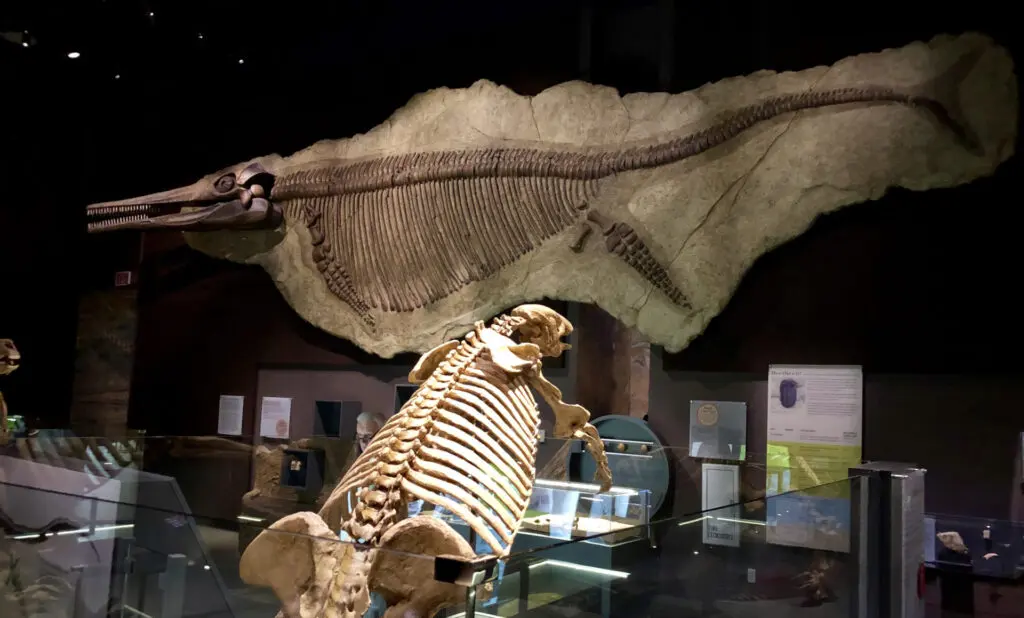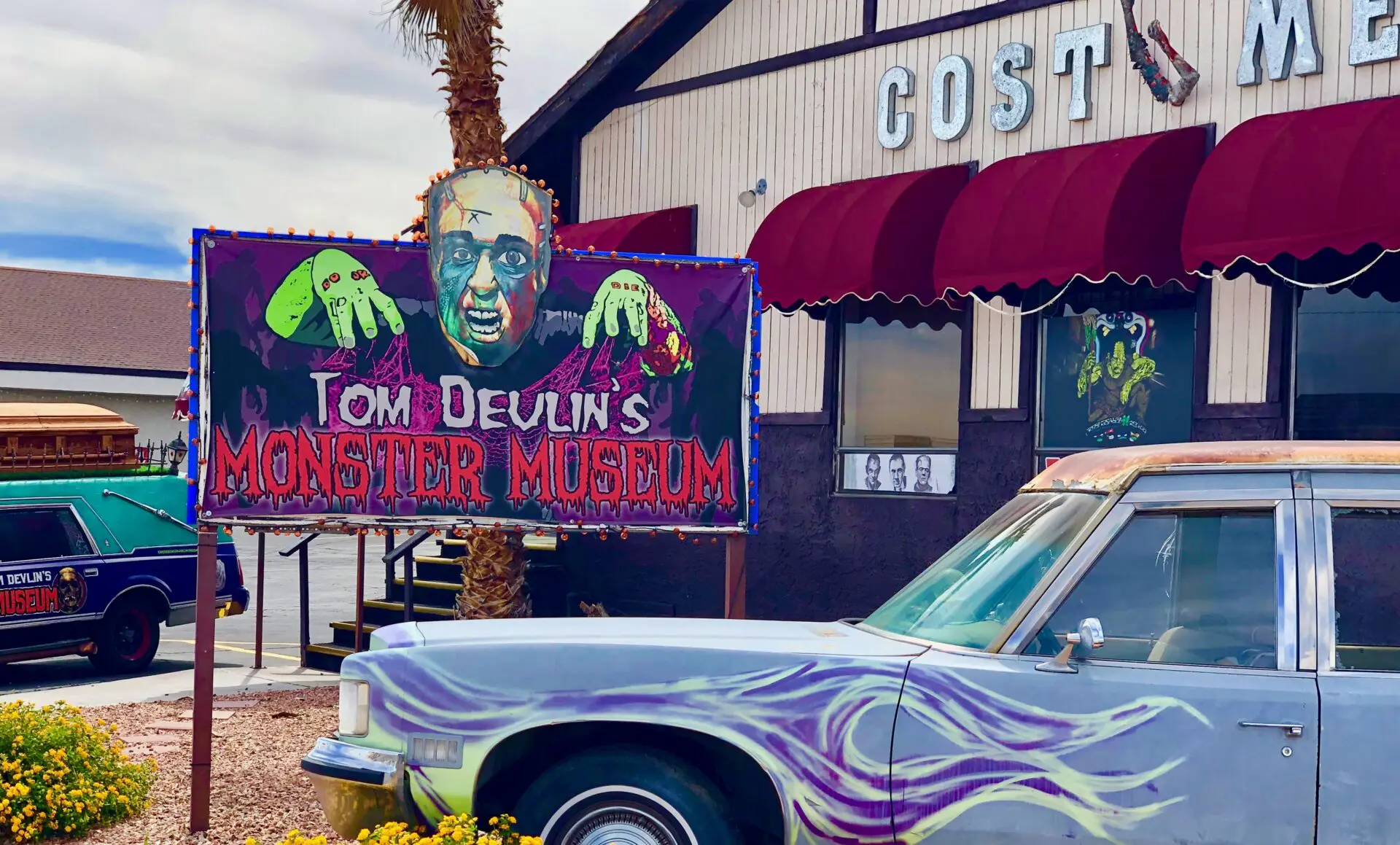
Interested in Vegas, huh? This isn’t all our knowledge, in fact it isn’t even the tip of the iceberg. Check out our app for tips, reviews and so much more…
A (very) deep dive into Vegas history
We aren’t afraid to admit it—we’re a bunch of history nerds. We love digging up old stories about the places we visit, and Vegas is no different. When we decided to write a guide to Vegas, we hit the history books first, and when we prepped our list of attractions we wanted to visit, museums were at the top of our list. Needless to say, the city didn’t disappoint. We’ve been to quite a few museums in our days, but Vegas has a very interesting history with a variety of cool topics, from the mob to the development of nuclear weapons and plenty in between. The museums that reflect these odd histories are worth a visit if you’ve got the time, and we talk about some of our absolute favorites below.
The Mob Museum

Located in the old courthouse and Post Office building, The Mob Museum is dedicated to the history of the mob and its effect on Las Vegas and the country at large. Officially the National Museum of Organized Crime and Law Enforcement, it’s a no-judgment depiction that includes lots of gory photos of mob hits, a great timeline of how the mob came to be in America, the massive effect that Prohibition had on their growth and success in the ’20s, their interactions with law enforcement and lots more.
They do a good job, and you can spend hours going through the different floors of exhibits. It’s $30 for general admission, though you can spend more for “special experiences.” We’d suggest the deluxe pass for $42, which includes one extra. We also recommend the distillery tour. It’s interesting, and you’ll get to sample their moonshine. Note that they only distill the ‘shine twice, so it has some pretty rough edges, but it’s worth a snort, and the history is fun to listen to while you imbibe. The distillery is adjacent to their speakeasy, which is dripping with yesteryear charm and opens at noon.
National Atomic Testing Museum

Though you may have come to town for the resorts, the food, the shows and the nightlife, back in the ’50s people came in droves for a different kind of light show—the one driven by nuclear explosions. After the first one went off without any forewarning to local residents in 1951, people were furious. People will stop coming here if you keep blowing those things off, they cried. In fact, the opposite happened. Over the next decade the government exploded 100 atomic bombs in the desert less than 100 miles to the northwest, and catching the early morning light from these explosions became an enormous tourist draw. (Hydrogen bombs weren’t tested above ground there. Atomic bombs are measured in kilo or thousands of tons of TNT. Hydrogen or thermonuclear bombs use atomic bombs as their trigger. The latter are measured in the mega or millions of tons. Those doomsday weapons were tested above ground in the Marshall Islands.) Fortunately for Vegas, wind patterns blew the fallout away from here (to the detriment of poor St. George, Utah, farther away but downwind.)
This private National Atomic Testing Museum (which is associated with the Smithsonian) showcases the history of testing here through exhibits, videos and relics. Figure about 60–90 minutes to see it. Though not for everyone, if you have an interest in history or nuclear science, you’ll have a blast. (Sorry, I almost made it through the whole review without an explosion pun. Try not to go nuclear on me…)
Origen Museum

If the Nevada State Museum is geared a bit more to adults, the Origen Museum is more kid-friendly, though it’s not a straightforward kids’ museum. Origen is a natural history museum that looks at the forces that created the Las Vegas area, as well as the plants and animals that lived here before people were around. (By the way, we didn’t misspell the name. It’s supposed to be a combination of the words original and generations.) They have a theater that shows a great video of prehistoric Las Vegas. There is a flash flood exhibit where you stand on grates above an actual man-made flash flood. (It’s kind of nice seeing a water feature after spending time outside in the desert.)
Origen doesn’t only have natural history exhibits though. There’s also a Hoover Dam exhibit with video and some life-sized figures in period costumes at a land auction and on a train. You won’t likely spend as much time at Origen as you will at Nevada State Museum, but it’s definitely worth a stop.
Springs Preserve and Nevada State Museum are part of the same network of museums, and your entry fee will get you access to all three attractions.
Nevada State Museum

The impressive (and well-funded) Nevada State Museum makes a good first impression with their massive mammoth skeleton to start things off. (Yeah, mammoths, camels, horses, bison, dire wolves, ground sloths and saber-toothed cats roamed this area during the last ice age 20,000 years ago.)
The 13,000-square-foot permanent exhibit portion is well lit and nicely presented. You’ll move through sections about Native Americans, early settlers, miners, the railroad, ranchers, Hoover Dam and the beginnings of modern Vegas. The layout and overall exhibit quality make for an enjoyable time. The changing exhibit isn’t as slick and (by definition) changes, so who’s to say what you’ll get?
Springs Preserve

When you drive up, you are entering the Springs Preserve. You won’t realize it yet, but this is the reason you are here, in Las Vegas. In fact, this is the reason every human for the last 1,000 years came to this area. If it wasn’t for this miraculous feature a third of a mile from the parking lot, this whole area would probably be called El Desierto, the desert. This preserve contains the site of the original spring that brought 4,000 gallons of water a minute to a lifeless land.
Once you pay your entrance fee, you can hit the museums or visit the springs site. Unfortunately, the spring stopped flowing decades ago. Water had been shooting out of the ground from a pressurized aquifer below for thousands of years. But in the 1900s the spring wasn’t delivering water fast enough to accommodate the growing population, so people started pumping water from the ground. The aquifer became less and less pressurized until 1962, when there was no longer enough pressure to send water to the surface, and the spring ran dry.
In the early 2000s work began to restore the pool that was here for eons. There was no way to make the spring flow naturally again, but with a little grading and some infrastructure work, there is now a pond where the original used to be, and it looks lovely in the otherwise arid surroundings. It’s actually humbling to stand beside it, knowing how important this site is to Las Vegas. You can walk to it, but, surprisingly, it’s not well marked. You might not even find it on the Springs Preserve app that you can download. It’s in a depression of land in the northeastern part of the property.
Nevada State Railroad Museum

We wouldn’t necessarily identify as trainheads (that’s what they’re called, right?). We don’t collect miniatures or own a conductor’s hat (although, now that we think about it, that does sound like a must-buy). All things considered, we found the Nevada State Railroad Museum to be a nice, charming outdoor exhibit. It’s more like a train graveyard than a museum, but it’s kind of cool to take a peek around the derelict engines. There’re a few trains you can wander through, set up like they presumably would have been back in the days of yore. It won’t take up much time and isn’t worth driving out here exclusively for the train museum. But if you find yourself in the area—perhaps after visiting Hoover Dam—take a moment to experience the quaintness of the place. It’s spotless—even the dang bathrooms. Open during the week, but rides are only available some weekends, so call ahead. You can also engineer one of these babies (Wednesday through Friday) for one hour running a diesel-electric locomotive along the historic tracks (with a licensed engineer) for $250, but you’ll need to reserve at least two weeks in advance and be over 18.
Titanic Artifact Exhibition

We all know the story, and we all think we know what to expect. It’s one thing to see the movie, and quite another to see parts of the real thing. The Titanic Exhibition is a journey through artifacts from the great ship that sank in 1912 as well as photos and video along with lots of signage.
It starts rather straightforwardly and feels perhaps a bit dry. Then, as you move through, you notice that some of the hallways are designed to look like those on the actual ship. The experience builds as you get to the grand staircase, which they say is an exact replica. Then you’re given the opportunity to spend $20 to buy a photo of you standing on it.
Once you reach the promenade deck, things start to turn dramatic as you become a part of the sinking ship. There is a large slab of ice on one side, and the actual remains of the wheel that turned the ship in the frantic but futile effort to avoid the iceberg it ultimately struck. The next room puts you on the bottom of the ocean where the wreckage was found. Read the story of the dishes found stacked so neatly on the sea floor and how they got that way. The replica of the Titanic as it was found is surreal. And at the end you see an enormous piece of the ship—26-feet-by-12-feet long with the massive rivets holding it together. They raised the huge piece in 1996, dropped it back to the sea floor by accident, then hauled it up for good in 1998.
Perhaps because the story of Titanic is so embedded in most of us, it feels more real than simply an exhibit about some unknown shipwreck. It’s a very cool exhibit either way. Allow at least an hour to go through it all.
Tom Devlin’s Monster Museum

Just because you haven’t heard of Tom Devlin doesn’t mean you won’t recognize his work. His monster museum aims to preserve “the art and history of special makeup effects.” The little walk-through museum is a collection of memorabilia from a plethora of classic films like The Exorcist to lesser known works like Poultry Geist (about a man-eating chicken, obviously). The collection includes props used on-screen, creature suits and custom pieces. Even if you aren’t a movie buff, you’ll probably have fun cringing at the still-creepy costumes or getting lost in the nostalgia of your favorite horror film villains. It isn’t an especially big museum, but there’s a lot stuffed in there.
Museums

Tom Devlin’s Monster Museum
Even if you don’t know Tom Devlin by name, you’ll likely recognize his work. This walk-through museum showcases memorabilia from classic films like The Exorcist to lesser-known works like Poultrygeist. You’ll find on-screen props, creature suits, and custom pieces.
Zak Bagan’s Haunted Museum

Zak Bagans’ Haunted Museum is put together by the star of reality show “Ghost Adventures” and the fandom is strong here. You can tell by the entry lines where people can easily spend two hours (or longer), but have no fear! You’re handed a form to fill out during your wait, signing away your health and safety (they can’t be held responsible if a ghost follows you home, for example).
You stand in line not for entrance into the museum but for a tour of the many-roomed house decorated with objects because of their paranormal significance, sinister history or sometimes just old-timey aesthetic.
Over about two hours the tour leads you through approximately 20–25 rooms with themes like serial killers, creepy dolls, or the circus/freak show. The museum boasts of celebrity visitors who began the tour as skeptics but left convinced of demons and spirits. Unfortunately, we came as skeptics and left more skeptical, but not everyone can have a paranormal awakening, eh?
Some rooms are (metaphorically) darker than others, whether you believe or not. They warn you about the most “paranormal” objects or rooms, and you can always choose to skip any part that gives you the heebie-jeebies. The guides have stories of their own interactions with the paranormal and about visitors fainting or having panic attacks. They place emphasis on objects like haunted mirrors or the staircase from the Gary, Indiana, “Demon House,” (one of the most famous hauntings and the subject of a documentary made by Zak) but we found the tangible just as creepy as the paranormal claims. A photo of the late comedian Chris Farley’s body covered in blood or the room with a journal detailing a killer’s torture methods appealed to our macabre side while also making us feel unnecessarily voyeuristic.
If you’re jumpy, the tour houses only three human-produced frights (subject to change)—one is in the taxidermy room, and the others are in the circus hallway.
All the guides have Zak’s dramatic lilting tones and are very knowledgeable (and at least feign total belief) even off their script. We’ll say that it’s probably worth the $48, but not the incredibly frustrating wait (especially in harsh conditions with no protection). But chances are if you’re a fan of Zak’s or of “Ghost Adventures,” then you won’t give a darn what we say.
Check out our Las Vegas app today!
Honestly, this isn’t even all of the museums we fell in love with while we were out in Vegas. We learned a ton from these museums, sure, but there are a lot more worth checking out in the city and beyond. Some people might write in and say, “What about Hoover Dam? Why isn’t that on the list?” Well, we can’t fit all of our museum reviews in this list. That’s why we built an app. Our Las Vegas travel app has hundreds of reviews that cover the history, culture and some amazing sights and activities throughout the Vegas area. We visit every place we write about so you know exactly what’s worth visiting, so if you’re looking for the next museum, attraction or activity company for your dream vacation, visit the app store and download our app today!




0 Comments